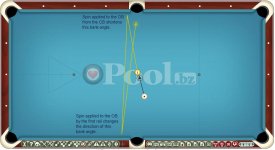Banks
Banned
Yes well, let me know when the next physicist pool tournament is. I'm sure that will be a hoot.
Seriously, what application in pool does this information REALLY have? Is this information going to change your shot selection? I mean, perhaps I'm not giving this a lot of thought but I can't think of a single instance where I would play a shot differently because of spin transferred to the object ball.
It's mostly used for banking, since shots normally go from hit to pocket(ideally). It can also be used to make the ball more pallatable to the pocket, so to say.
I'm sorry but now you have officially lost me. The moment that object ball hits a rail, that rail is imparting spin on it, not the cueball. Perhaps you're talking about throw.
Nope, a standard twist bank uses collision-induced spin from cutting towards the bank(and should be hit at a decent speed to avoid overspin). When you cut a bank, spin is imparted in the general direction of the cut. If you cut away from a bank, collision spin is created away from the angle and shortens it up. If you cut towards a bank, spin is created towards the angle and lengths the bank.
Please don't go off the deep end on this subject. The next time you're at a table, set up simply short banks and aim them directly into the rail(ie- diamond to diamond). Shoot them with medium/slow speed and start putting different english on the ball. You'll see the difference after only a little bit.

